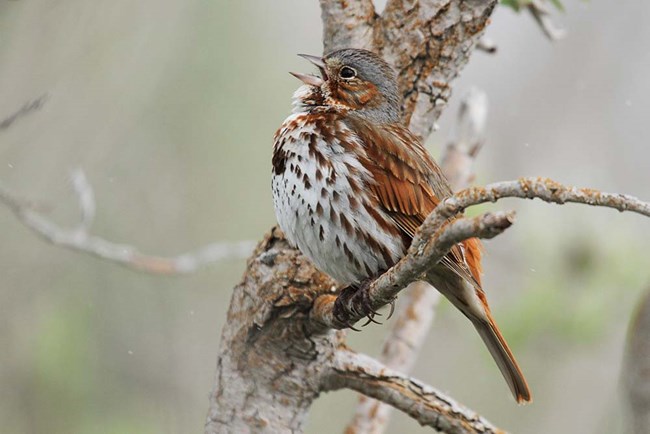Last updated: May 2, 2023
Article
How weather and climate affect songbirds

NPS/Jared Hughey
As we know, weather varies from year to year and climate is the long-term trend of weather patterns. Songbirds, like many species, are impacted by both short-term weather and by long-term climate. But what are those effects and how exactly do they respond? We used the number of songbirds (the abundance of passerines or perching birds) from 1995-2019 counts in Denali National Park and Preserve to assess how the weather from the previous year impacted the current year and how the impacts of climate have shifted bird locations in elevation over the last 20 years.
We found that weather and climate can have complex and sometimes conflicting forces on songbirds and that songbird species don’t all respond in the same way. For example, in songbirds that use shrub habitats, we found their numbers increased in the year following a warm nesting season, but over a long-term warming climate trend decreased in number and shifted upslope as shrubs also shifted to higher elevations. Overall, the temperature during the previous year’s nesting period had the greatest short-term impact on the number of songbirds we observed. The amount of rain and snow, and the timing of snowmelt, affected different songbird species in different ways, but we found generally that drier and earlier snowmelt led to a greater abundance of songbirds. Understanding how songbird populations are impacted by climate in the long-term and annually by weather will help us understand the changes we see in subarctic songbirds over time.
Climate and weather have differential effects in a high latitude passerine community
Abstract
Climatic factors act on populations at multiple timescales leading to the separation of long-term climate and shorter-term weather effects. We used passerine counts from 1995 to 2019 in subarctic Alaska (Denali National Park, USA) to assess the impacts of the prior breeding season’s weather on breeding season abundance and the impacts of climate measured through shifts in elevational distribution. Weather and climate appear to have had opposing effects on the abundance of some shrub-associated species as evidenced by a positive response to nesting phase temperature over a 1-year lag and a negative response to warming-induced shifts in shrub-dominated habitats over the long term. The latter response was indicated by declines in abundance which occurred in some part through portions of these populations shifting upslope of our fixed sampling frame. Overall, the abundance of species was related to one or more of the lagged effects of weather and the effects of weather alone drove nearly twofold variation in annual abundance in most species. The effect of nesting phase temperature was a strong positive predictor at both community and individual species levels, whereas arrival phase temperature had weak support at both levels. The effects of total precipitation during the nesting phase and snowmelt timing shared mixed support at community and species levels, but generally indicated higher abundance following seasons that were drier and had earlier snowmelt. Together, our findings of opposing effects of climatic variables at different timescales have implications for understanding the mechanisms of population and distributional change in passerines in the subarctic.
Mizel, J.D., J. H. Schmidt, and C. L. McIntyre. 2021. Climate and weather have differential effects in a high-latitude passerine community. Oecologia.
